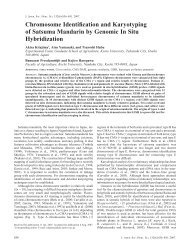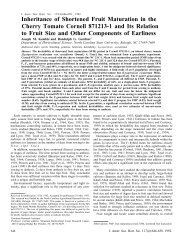Consumer Tastes, Preferences, and Behavior in Purchasing Fresh ...
Consumer Tastes, Preferences, and Behavior in Purchasing Fresh ...
Consumer Tastes, Preferences, and Behavior in Purchasing Fresh ...
Create successful ePaper yourself
Turn your PDF publications into a flip-book with our unique Google optimized e-Paper software.
determ<strong>in</strong>ants of dem<strong>and</strong> for the product. The estimated equation is<br />
further expla<strong>in</strong>ed below.<br />
Price. The price variable was statistically significant <strong>in</strong> both<br />
dem<strong>and</strong> equations. The larger absolute value of the price elasticity<br />
for tomatoes other than Jersey <strong>Fresh</strong> tomatoes <strong>in</strong>dicates that<br />
consumers are less sensitive to changes <strong>in</strong> the price of Jersey <strong>Fresh</strong><br />
than to changes <strong>in</strong> the price of other tomatoes <strong>and</strong>, hence, they may<br />
perceive Jersey <strong>Fresh</strong> tomatoes to be of higher quality than are<br />
tomatoes from other sources. Specifically, if price for both products<br />
<strong>in</strong>creases by 1%, the percent decrease <strong>in</strong> the quantity dem<strong>and</strong>ed<br />
of Jersey <strong>Fresh</strong> tomatoes will be less than the decrease <strong>in</strong><br />
the dem<strong>and</strong> for other tomatoes.<br />
Price of substitutes. The significance of the price of substitutes<br />
<strong>in</strong> both dem<strong>and</strong> equations suggests that both types of tomatoes are<br />
substitutes for each other. The cross-price elasticity of dem<strong>and</strong> for<br />
Jersey <strong>Fresh</strong> with respect to the price of other tomatoes is lower<br />
than that of other tomatoes with respect to the price of Jersey <strong>Fresh</strong>.<br />
This may <strong>in</strong>dicate that consumers perceive Jersey <strong>Fresh</strong> tomatoes<br />
to have fewer substitutes than do other tomatoes. The implications<br />
are: 1) When the price of other tomatoes <strong>in</strong>creases, consumers<br />
purchase more Jersey <strong>Fresh</strong> <strong>and</strong> fewer other tomatoes. 2) When the<br />
price of Jersey <strong>Fresh</strong> <strong>in</strong>creases, consumers purchase more of other<br />
tomatoes <strong>and</strong> fewer Jersey <strong>Fresh</strong>. 3) The <strong>in</strong>crease <strong>in</strong> the quantity of<br />
Jersey <strong>Fresh</strong> from the first case exceeds the <strong>in</strong>crease <strong>in</strong> the quantity<br />
of other tomatoes <strong>in</strong> the second case. This is further evidence that<br />
Jersey <strong>Fresh</strong> tomatoes are perceived to be a differentiated <strong>and</strong> more<br />
preferred product.<br />
Income. The <strong>in</strong>come coefficient, although significant for all<br />
tomatoes, was larger for Jersey <strong>Fresh</strong> than for other tomatoes,<br />
suggest<strong>in</strong>g that Jersey <strong>Fresh</strong> tomatoes are more <strong>in</strong>come elastic than<br />
other tomatoes. The implications are that higher <strong>in</strong>come <strong>in</strong>dividuals<br />
are more likely to purchase the Jersey <strong>Fresh</strong> tomato, <strong>and</strong> that as<br />
<strong>in</strong>come <strong>in</strong>creases, Jersey <strong>Fresh</strong>’s appeal <strong>and</strong> dem<strong>and</strong> should <strong>in</strong>crease.<br />
This result also suggests that Jersey <strong>Fresh</strong> tomatoes are<br />
preferred over other tomatoes.<br />
Taste <strong>and</strong> preference variables. When all factors related to taste<br />
<strong>and</strong> preference were considered simultaneously <strong>in</strong> the dem<strong>and</strong><br />
model, the only taste <strong>and</strong> preference variables that were significant<br />
at P= 0.05 or 0.10 were product orig<strong>in</strong> <strong>and</strong> overall quality. To<br />
determ<strong>in</strong>e if the other taste <strong>and</strong> preference variables were <strong>in</strong>significant<br />
as a result of multicoll<strong>in</strong>earity, a nonstructured test to detect<br />
coll<strong>in</strong>earity between <strong>in</strong>come <strong>and</strong> other demographic variables was<br />
applied to Eq. 1. Results <strong>in</strong>dicated multicoll<strong>in</strong>earity between the<br />
overall variable <strong>and</strong> other taste <strong>and</strong> preference variables. Therefore,<br />
orig<strong>in</strong> <strong>and</strong> overall preference variables were reta<strong>in</strong>ed <strong>in</strong> the<br />
436<br />
f<strong>in</strong>al equation <strong>and</strong> other taste <strong>and</strong> preference variables were<br />
dropped to reduce multicoll<strong>in</strong>earity.<br />
In the f<strong>in</strong>al equation, the coefficient of the orig<strong>in</strong> variable for<br />
Jersey <strong>Fresh</strong> tomatoes was positive <strong>and</strong> had a larger absolute value<br />
than the negative coefficient for other tomatoes. Respondents who<br />
said orig<strong>in</strong> was important, purchased more Jersey tomatoes <strong>and</strong><br />
fewer other tomatoes than did respondents who did not feel orig<strong>in</strong><br />
was important. Given the significance of the orig<strong>in</strong> variable, it<br />
appears that characteristics of the tomato itself are not the only<br />
factors that consumers consider when mak<strong>in</strong>g their purchas<strong>in</strong>g<br />
decisions. This suggests br<strong>and</strong> loyalty to Jersey <strong>Fresh</strong>.<br />
Given the problem with multicoll<strong>in</strong>earity, an attempt was made<br />
to <strong>in</strong>vestigate how taste variables perform <strong>in</strong>dividually. When<br />
freshness, flavor, nutrition, <strong>and</strong> overall consumer perceptions<br />
were added to the dem<strong>and</strong> equation as a group, they were nonsignificant,<br />
but when added one at a time with the orig<strong>in</strong> variable, they<br />
were all significant. This result implies that consumers are not able<br />
to separate their <strong>in</strong>dividual perception factors, <strong>and</strong> that consumers<br />
look at a group of attributes <strong>in</strong> mak<strong>in</strong>g their fresh tomato-purchas<strong>in</strong>g<br />
decisions rather than rely<strong>in</strong>g on a s<strong>in</strong>gle attribute.<br />
Another reason why some of these factors (e.g., flavor, storage<br />
life, <strong>and</strong> nutrition) were not significant may be that consumers<br />
cannot determ<strong>in</strong>e these factors at the time of purchase. <strong>Consumer</strong>s<br />
must resort to other attributes <strong>in</strong> mak<strong>in</strong>g their purchase decisions<br />
<strong>and</strong> these factors become difficult for consumers to separate from<br />
each other. While not significant <strong>in</strong> the f<strong>in</strong>al equation, nutrition of<br />
Jersey <strong>Fresh</strong> tomatoes was thought to be better that other tomatoes<br />
by one third of the respondents. People who believed that Jersey<br />
<strong>Fresh</strong> tomatoes were more nutritious than other tomatoes purchased<br />
more Jersey <strong>Fresh</strong> tomatoes than other tomatoes.<br />
Like nutrition <strong>and</strong> freshness, flavor was significant when added<br />
to the dem<strong>and</strong> equation with price, price of substitutes, <strong>in</strong>come,<br />
<strong>and</strong> overall preference, but was not significant when all of the taste<br />
<strong>and</strong> preference variables were <strong>in</strong>cluded <strong>in</strong> the dem<strong>and</strong> equation.<br />
While flavor was the most common cause for past disappo<strong>in</strong>tment,<br />
apparently consumers did not associate attributes that would result<br />
<strong>in</strong> better flavor with a particular type of tomato.<br />
Time of year is related to orig<strong>in</strong>, s<strong>in</strong>ce Jersey <strong>Fresh</strong> tomatoes are<br />
only available dur<strong>in</strong>g the summer months; however, time of year<br />
was nonsignificant <strong>in</strong> the dem<strong>and</strong> equation, possibly because of<br />
coll<strong>in</strong>earity between orig<strong>in</strong> <strong>and</strong> time of year. Respondents’ stated<br />
perception of price as a factor <strong>in</strong> their purchase decisions <strong>and</strong> their<br />
attitudes about how the price of Jersey <strong>Fresh</strong> tomatoes compared<br />
to other tomatoes were not significant <strong>in</strong> the dem<strong>and</strong> equation.<br />
However, actual purchase prices were significant <strong>in</strong> the dem<strong>and</strong><br />
J. Amer. Soc. Hort. Sci. 118(3):433-438. 1993.
















